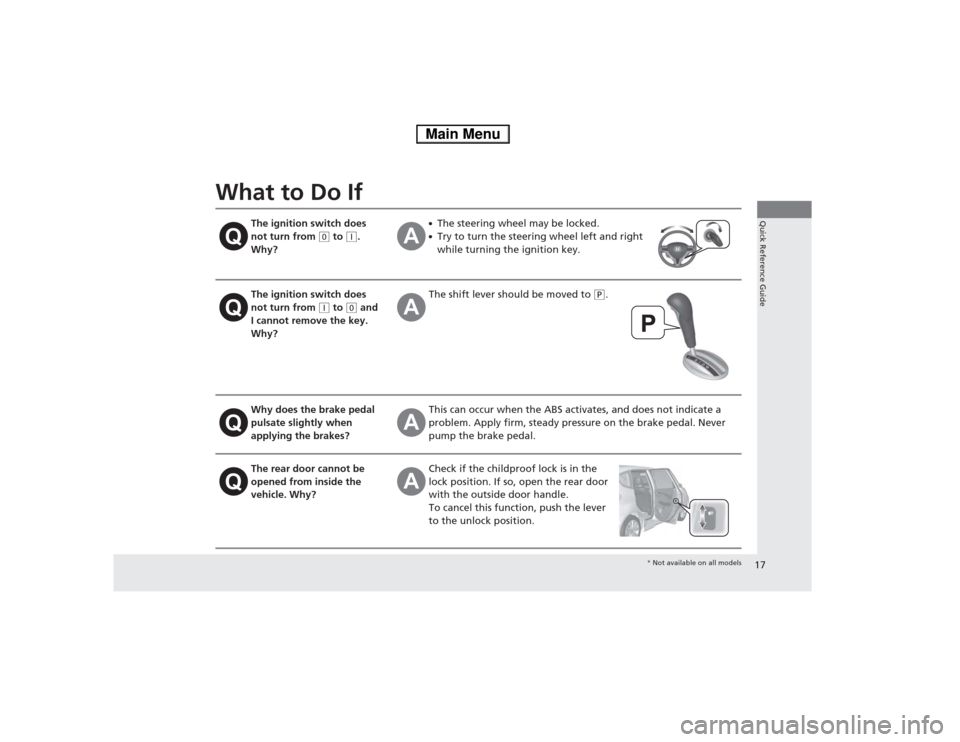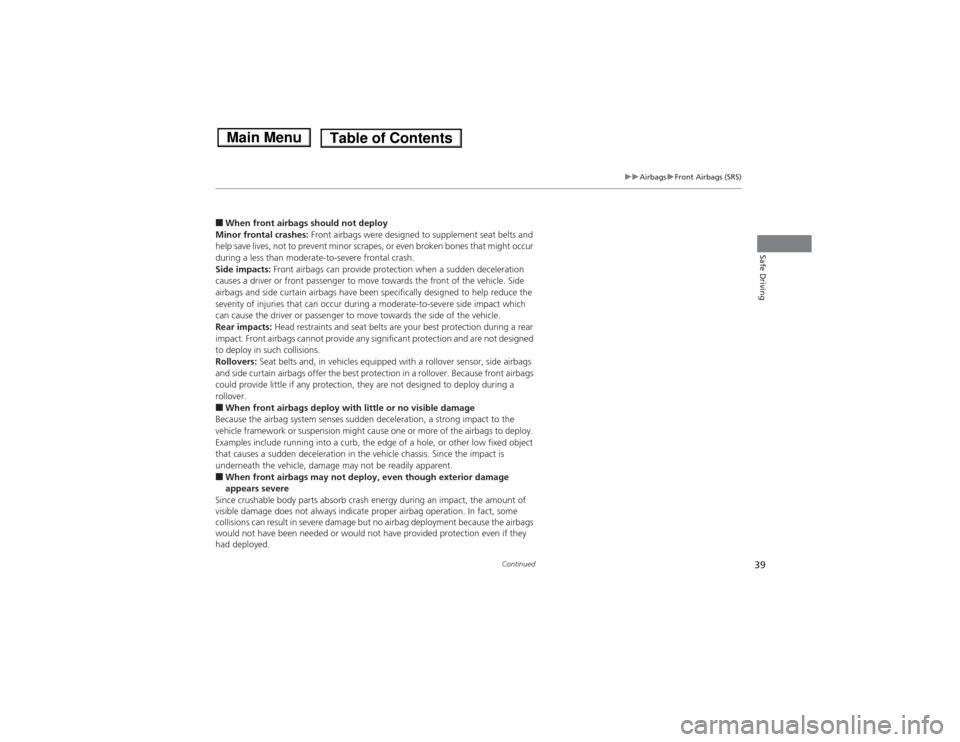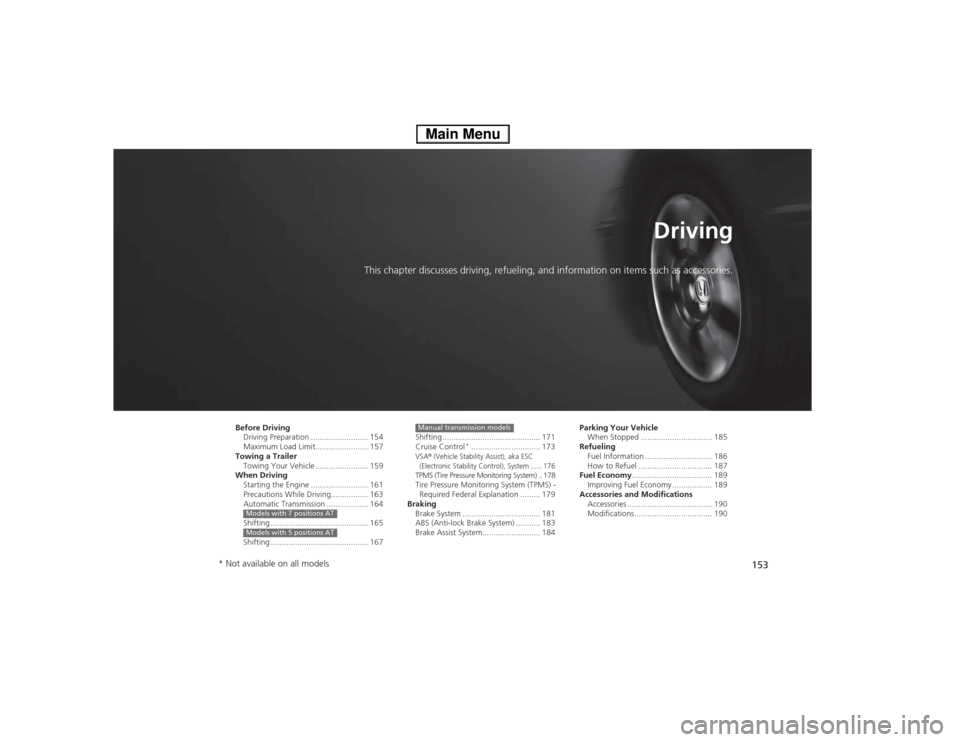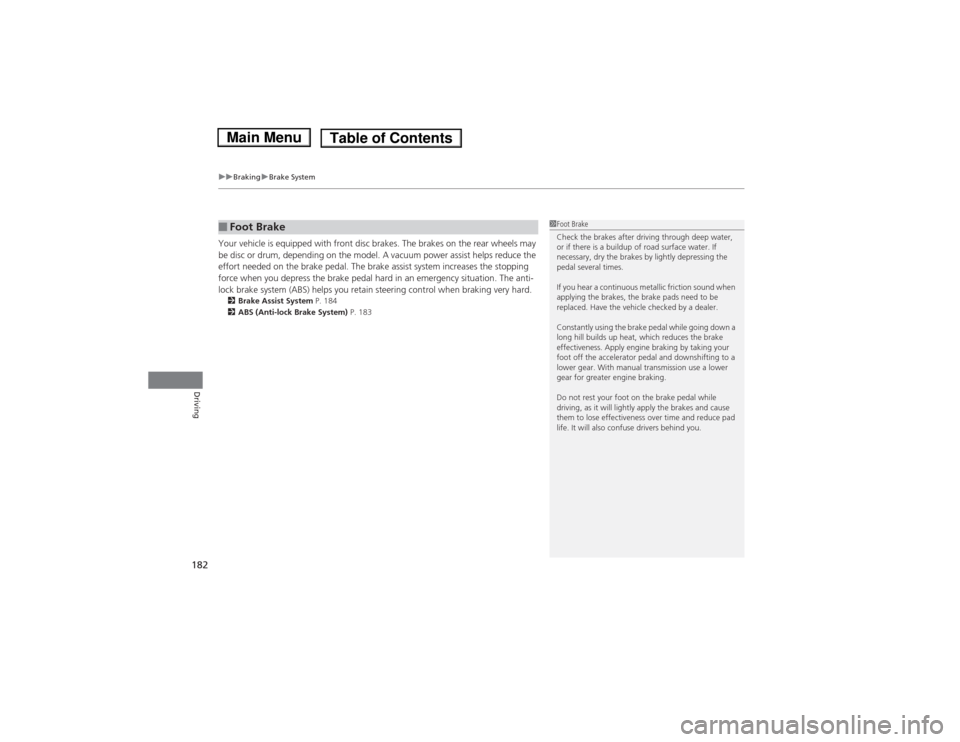2014 HONDA FIT ABS
[x] Cancel search: ABSPage 9 of 289

8Quick Reference Guide
Instrument Panel
(P63)
Lights Reminders
Malfunction
Indicator Lamp
Low Oil Pressure
Indicator
Anti-lock Brake
System (ABS)
Indicator Vehicle Stability
Assist (VSA®) System
Indicator
VSA® OFF Indicator
Electric Power
Steering (EPS)
Indicator Lights On Indicator High Beam Indicator
Immobilizer System
Indicator
Seat Belt Reminder
Indicator
System Indicators
CRUISE MAIN
Indicator
*
Supplemental
Restraint System
Indicator Side Airbag Off
Indicator
Door and Tailgate
Open Indicator
TachometerSpeedometerFuel Gauge Security System Alarm Indicator
*
Shift Lever Position Indicator
*
Low Fuel Indicator
Gauges
(P72)
/Information Display
(P73)
/System Indicators
(P64)
Turn Signal and
Hazard Warning
Indicators High Temperature
Indicator
Low Temperature
Indicator
System Indicators System Indicators
Low Tire Pressure
IndicatorU.S. models only
Parking Brake
and Brake System
Indicator
CRUISE CONTROL
Indicator
*
System Indicators
Charging System
Indicator
U.S.U.S.Canada
TPMS IndicatorU.S. models onlyWasher Level
Indicator
*
Daytime Running
Lights Indicator
*
Maintenance
Minder Indicator Fog Light Indicator
*
Canada
Page 18 of 289

17Quick Reference Guide
What to Do If
The ignition switch does
not turn from
(0 to
(q.
Why?
●The steering wheel may be locked.●Try to turn the steering wheel left and right
while turning the ignition key.
The ignition switch does
not turn from
(q to
(0 and
I cannot remove the key.
Why?
The shift lever should be moved to
(P.
Why does the brake pedal
pulsate slightly when
applying the brakes?
This can occur when the ABS activates, and does not indicate a
problem. Apply firm, steady pressure on the brake pedal. Never
pump the brake pedal.
The rear door cannot be
opened from inside the
vehicle. Why?
Check if the childproof lock is in the
lock position. If so, open the rear door
with the outside door handle.
To cancel this function, push the lever
to the unlock position.
* Not available on all models
Page 40 of 289

39
uuAirbagsuFront Airbags (SRS)
Continued
Safe Driving
■When front airbags should not deploy
Minor frontal crashes: Front airbags were designed to supplement seat belts and
help save lives, not to prevent minor scrapes, or even broken bones that might occur
during a less than moderate-to-severe frontal crash.
Side impacts: Front airbags can provide protection when a sudden deceleration
causes a driver or front passenger to move towards the front of the vehicle. Side
airbags and side curtain airbags have been specifically designed to help reduce the
severity of injuries that can occur during a moderate-to-severe side impact which
can cause the driver or passenger to move towards the side of the vehicle.
Rear impacts: Head restraints and seat belts are your best protection during a rear
impact. Front airbags cannot provide any significant protection and are not designed
to deploy in such collisions.
Rollovers: Seat belts and, in vehicles equipped with a rollover sensor, side airbags
and side curtain airbags offer the best protection in a rollover. Because front airbags
could provide little if any protection, they are not designed to deploy during a
rollover.■When front airbags deploy with little or no visible damage
Because the airbag system senses sudden deceleration, a strong impact to the
vehicle framework or suspension might cause one or more of the airbags to deploy.
Examples include running into a curb, the edge of a hole, or other low fixed object
that causes a sudden deceleration in the vehicle chassis. Since the impact is
underneath the vehicle, damage may not be readily apparent.■When front airbags may not deploy, even though exterior damage
appears severe
Since crushable body parts absorb crash energy during an impact, the amount of
visible damage does not always indicate proper airbag operation. In fact, some
collisions can result in severe damage but no airbag deployment because the airbags
would not have been needed or would not have provided protection even if they
had deployed.
Page 43 of 289

42
uuAirbagsuSide Airbags
Safe Driving
■When a side airbag deploys with little or no visible damage
Because the airbag systems senses sudden acceleration, a strong impact to the side
of the vehicle’s framework can cause a side airbag to deploy. In such cases, there
may be little or no damage, but the side impact sensors detected a severe enough
impact to deploy the airbag.■When a side airbag may not deploy, even though visible damage appears
severe
It is possible for a side airbag to not deploy during an impact that results in
apparently severe damage. This can occur when the point of impact was towards
the far front or rear of the vehicle, or when the vehicle’s crushable body parts
absorbed most of the crash energy. In either case, the side airbag would not have
been needed nor provided protection even if it had deployed.
Page 65 of 289

64Instrument Panel
IndicatorsIndicator
Name
On/Blinking
Explanation
Parking Brake and
Brake System
Indicator
●Comes on for a few seconds when you
turn the ignition switch to ON
(w, then
goes off.
●Comes on when the parking brake is
applied, and goes off when it is released.●Comes on when the brake fluid level is
low.●Comes on if there is a problem with the
brake system.●The beeper sounds and the indicator
comes on if you drive with the parking
brake not fully released.
●Comes on while driving - Make sure the parking
brake is released. Check the brake fluid level.
2What to do when the indicator comes on while
driving P. 258
●Comes on along with the ABS indicator - Have
the vehicle checked by a dealer.
2If the Brake System Indicator Comes On P. 258
Low Oil Pressure
Indicator
●Comes on when you turn the ignition
switch to ON
(w, and goes off when the
engine starts.
●Comes on when the engine oil pressure
is low.
●Comes on while driving - Immediately stop in a
safe place.
2If the Low Oil Pressure Indicator Comes On
P. 256
U.S.Canada
Page 68 of 289

67
uuIndicatorsu
Continued
Instrument Panel
Indicator
Name
On/Blinking
Explanation
ABS (Anti-lock
Brake System)
Indicator
●Comes on for a few seconds when you
turn the ignition switch to ON
(w, then
goes off.
●If it comes on at any other time, there is
a problem with the ABS.
●Stays on constantly - Have the vehicle checked by
a dealer. With this indicator on, your vehicle still has
normal braking ability but no anti-lock function.
2ABS (Anti-lock Brake System) P. 183
Supplemental
Restraint System
Indicator
●Comes on for a few seconds when you
turn the ignition switch to ON
(w, then
goes off.
●Comes on if a problem with any of the
following is detected:
-Supplemental restraint system
-Side airbag system
-Side curtain airbag system
-Seat belt tensioner
●Stays on constantly or does not come on at all
- Have the vehicle checked by a dealer.
High Temperature
Indicator
●Comes on for a few seconds when you
turn the ignition switch to ON
(w, then
goes off.
●Blinks when the engine coolant
temperature goes up, and stays on if the
temperature continues to rise.
●Blinks while driving - Drive slowly to prevent
overheating.●Stays on while driving - Immediately stop in a
safe place and allow the engine to cool.
2Overheating P. 254
Low Temperature
Indicator
●Comes on for a few seconds when you
turn the ignition switch to ON
(w.
●Comes on when the engine coolant
temperature is low.
●If the indicator stays on after the engine has reached
normal operating temperature, there may be a
problem with the temperature sensors. Have the
vehicle inspected by a dealer.
Page 154 of 289

153
Driving
This chapter discusses driving, refueling, and information on items such as accessories.
Before Driving
Driving Preparation .......................... 154
Maximum Load Limit........................ 157
Towing a Trailer
Towing Your Vehicle ........................ 159
When Driving
Starting the Engine .......................... 161
Precautions While Driving................. 163
Automatic Transmission ................... 164
Shifting ............................................ 165
Shifting ............................................ 167Models with 7 positions ATModels with 5 positions AT
Shifting ............................................ 171
Cruise Control
*............................... 173
VSA
® (Vehicle Stability Assist), aka ESC
(Electronic Stability Control), System ...... 176
TPMS (Tire Pressure Monitoring System) .. 178Tire Pressure Monitoring System (TPMS) -
Required Federal Explanation ......... 179
Braking
Brake System ................................... 181
ABS (Anti-lock Brake System) ........... 183
Brake Assist System.......................... 184Manual transmission models
Parking Your Vehicle
When Stopped ................................ 185
Refueling
Fuel Information .............................. 186
How to Refuel ................................. 187
Fuel Economy.................................... 189
Improving Fuel Economy .................. 189
Accessories and Modifications
Accessories ...................................... 190
Modifications................................... 190
* Not available on all models
Page 183 of 289

uuBrakinguBrake System
182Driving
Your vehicle is equipped with front disc brakes. The brakes on the rear wheels may
be disc or drum, depending on the model. A vacuum power assist helps reduce the
effort needed on the brake pedal. The brake assist system increases the stopping
force when you depress the brake pedal hard in an emergency situation. The anti-
lock brake system (ABS) helps you retain steering control when braking very hard.2Brake Assist System P. 184
2ABS (Anti-lock Brake System) P. 183■Foot Brake
1Foot Brake
Check the brakes after driving through deep water,
or if there is a buildup of road surface water. If
necessary, dry the brakes by lightly depressing the
pedal several times.
If you hear a continuous metallic friction sound when
applying the brakes, the brake pads need to be
replaced. Have the vehicle checked by a dealer.
Constantly using the brake pedal while going down a
long hill builds up heat, which reduces the brake
effectiveness. Apply engine braking by taking your
foot off the accelerator pedal and downshifting to a
lower gear. With manual transmission use a lower
gear for greater engine braking.
Do not rest your foot on the brake pedal while
driving, as it will lightly apply the brakes and cause
them to lose effectiveness over time and reduce pad
life. It will also confuse drivers behind you.